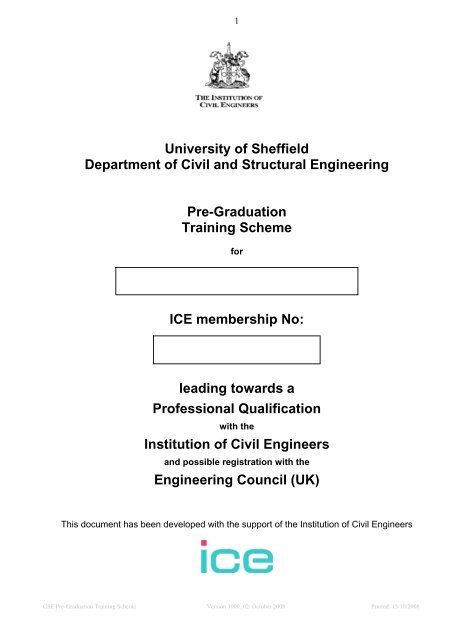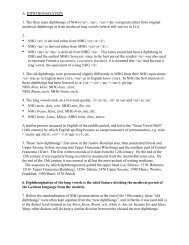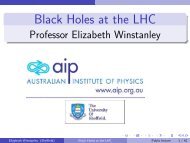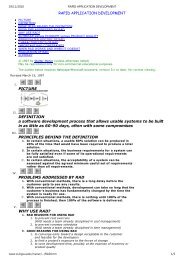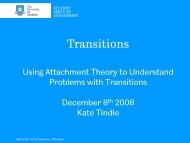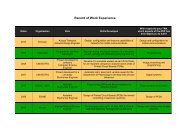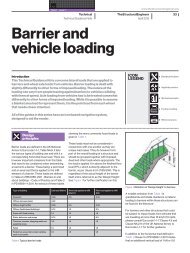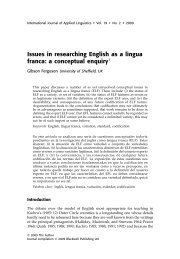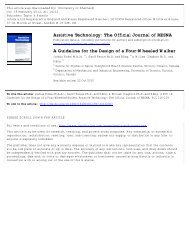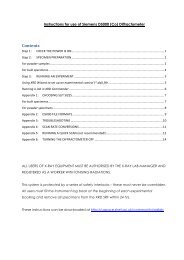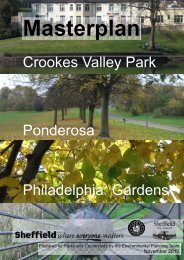PGTS v3-08.pdf - University of Sheffield
PGTS v3-08.pdf - University of Sheffield
PGTS v3-08.pdf - University of Sheffield
You also want an ePaper? Increase the reach of your titles
YUMPU automatically turns print PDFs into web optimized ePapers that Google loves.
1<br />
<strong>University</strong> <strong>of</strong> <strong>Sheffield</strong><br />
Department <strong>of</strong> Civil and Structural Engineering<br />
Pre-Graduation<br />
Training Scheme<br />
for<br />
ICE membership No:<br />
leading towards a<br />
Pr<strong>of</strong>essional Qualification<br />
with the<br />
Institution <strong>of</strong> Civil Engineers<br />
and possible registration with the<br />
Engineering Council (UK)<br />
This document has been developed with the support <strong>of</strong> the Institution <strong>of</strong> Civil Engineers<br />
CSE Pre-Graduation Training Scheme Version 3000_02: October 2008 Printed: 15/10/2008
CSE Pre-Graduation Training Scheme Version 3000_02: October 2008 Printed: 15/10/2008<br />
2<br />
Contents<br />
Abbreviations 3<br />
Definitions <strong>of</strong> Terms 3<br />
1.0 Introduction 4<br />
2.0 <strong>University</strong> <strong>of</strong> <strong>Sheffield</strong> - Department <strong>of</strong> Civil and Structural Engineering 6<br />
2.1 The Department 6<br />
2.2 Pre-Graduation Training Policy 6<br />
3.0 Pr<strong>of</strong>essional Qualifications 9<br />
3.1 Why be Pr<strong>of</strong>essionally Qualified? 9<br />
3.2 Pr<strong>of</strong>essionally-qualified members 9<br />
Page<br />
4.0 Principles <strong>of</strong> the Scheme 11<br />
5.0 Requirements 12<br />
5.1 Development Objectives (DOs) 13<br />
5.2 Continuing Pr<strong>of</strong>essional Development (CPD) 14<br />
5.3 Breadth 14<br />
6.0 Keeping Your Development On Course 17<br />
(Monitoring, Assessing and Certifying your Achievement <strong>of</strong> the Requirements)<br />
6.1 Supervising Civil Engineer (SCE) 17<br />
6.2 First Steps 17<br />
6.3 Your Role 17<br />
6.4 Reviews and Appraisals 18<br />
6.4.1 Development Reviews 18<br />
6.4.2 Annual Appraisals 19<br />
6.4.3 Training Review 19<br />
6.4.4 ICE Reviews 19<br />
7.0 Sources <strong>of</strong> Help 20<br />
7.1 Your Supervising Civil Engineer (SCE) and Delegated Engineers (DEs) 20<br />
7.2 The Institution 21<br />
7.2.1 The Regional Support Team (RST) 21<br />
7.2.2 The ICE Region 21<br />
7.2.3 Great George Street 22<br />
8.0 Administration 23<br />
9.0 Towards the Pr<strong>of</strong>essional Review 24<br />
10.0 And Finally 24<br />
Appendices<br />
Appendix A Summary <strong>of</strong> Academic and Pr<strong>of</strong>essional Career 25<br />
Appendix B Training Programme 26<br />
Appendix C Record <strong>of</strong> Development Reports, Development Reviews and Annual<br />
Appraisals 27<br />
Appendix D Guidance on writing Development Reports 29
CSE Pre-Graduation Training Scheme Version 3000_02: October 2008 Printed: 15/10/2008<br />
3<br />
Abbreviations<br />
(Names in italics are EC UK grades)<br />
AMICE Associate Member <strong>of</strong> the ICE<br />
AR Achievement Rating<br />
CEng Chartered Engineer<br />
CPD Continuing Pr<strong>of</strong>essional Development<br />
CPR Chartered Pr<strong>of</strong>essional Review<br />
CPRP Chartered Pr<strong>of</strong>essional Review (Progressive)<br />
DAP Development Action Plan (for CPD)<br />
DE Delegated Engineer<br />
DO Development Objective<br />
EC UK Engineering Council (UK)<br />
EngTech Engineering Technician<br />
FICE Fellow <strong>of</strong> the ICE<br />
FL Further Learning<br />
G&S Graduates and Students<br />
GGS Great George Street<br />
ICE Institution <strong>of</strong> Civil Engineers<br />
IEng Incorporated Engineer<br />
IPD Initial Pr<strong>of</strong>essional Development<br />
MDO Membership Development Officer (<strong>of</strong> the ICE’s RST)<br />
MGN Membership Guidance Note<br />
MICE Member <strong>of</strong> the ICE<br />
MPR Member Pr<strong>of</strong>essional Review<br />
PDR Personal Development Record (<strong>of</strong> CPD)<br />
PR Pr<strong>of</strong>essional Review<br />
RST Regional Support Team (<strong>of</strong> the ICE)<br />
SCE Supervising Civil Engineer<br />
SE Supervising Engineer (<strong>of</strong> ICE or IStructE, supervising Further Learning)<br />
TMICE Technician Member <strong>of</strong> the ICE<br />
TPR Technician Pr<strong>of</strong>essional Review<br />
TRR Technical Report Route<br />
Definitions <strong>of</strong> Terms<br />
Pr<strong>of</strong>essionally-qualified MICE, TMICE or AMICE (also FICE)<br />
member<br />
member A member <strong>of</strong> the ICE <strong>of</strong> any class<br />
(ie, with a small initial letter)<br />
Graduate Member A member <strong>of</strong> the ICE who has achieved the Educational Base<br />
(from 2000) appropriate to any pr<strong>of</strong>essional qualification<br />
class The class <strong>of</strong> membership relevant to this Training Scheme,<br />
ie Member, Associate Member or Technician Member
1.0 Introduction<br />
The route to any pr<strong>of</strong>essional qualification may be considered to have three parts:<br />
• an Educational Base (academic requirements)<br />
• some experience and/or training<br />
• a final assessment (the Pr<strong>of</strong>essional Review).<br />
CSE Pre-Graduation Training Scheme Version 3000_02: October 2008 Printed: 15/10/2008<br />
4<br />
The period between achieving the Educational Base and the qualification (at the Pr<strong>of</strong>essional<br />
Review) is known as Initial Pr<strong>of</strong>essional Development (IPD). This document, designed in<br />
consultation with the Institution <strong>of</strong> Civil Engineers, describes the means by which you will build<br />
on the Educational Base to lead you towards the appropriate Pr<strong>of</strong>essional Review <strong>of</strong> the<br />
Institution <strong>of</strong> Civil Engineers. The requirements <strong>of</strong> this Training Scheme is therefore IPD and it<br />
consists <strong>of</strong> :<br />
• Development Objectives (DOs), which are a measure <strong>of</strong> competence, largely acquired<br />
through experience<br />
• Continuing Pr<strong>of</strong>essional Development (CPD) (increased knowledge, ie training) and<br />
increased breadth<br />
Anyone who does their job conscientiously and takes an interest in all its aspects would<br />
eventually be likely to achieve the Objectives for the Pr<strong>of</strong>essional Review. This Pre-graduation<br />
Training Scheme is included as part <strong>of</strong> the Department’s Personal Development Planning to<br />
provide a structured introduction to the full ICE training scheme, and participation can allow<br />
quicker and easier transition to a full training scheme and shorten the time to completion <strong>of</strong> the<br />
DOs after graduation.<br />
Students are encouraged to work towards achievement <strong>of</strong> the Development Objectives during<br />
their academic studies by monitoring and recording achievement and planning future<br />
opportunities. This Pre-Graduation Scheme document describes how your development can be<br />
monitored, assessed, certified and kept on course for completion in the shortest time possible<br />
as part <strong>of</strong> a full ICE training scheme.<br />
The following ICE documents, current at the beginning <strong>of</strong> your Training Agreement, should be<br />
read in conjunction with this Training Scheme. You should ensure that your Pr<strong>of</strong>essional<br />
Development Portfolio always contains the relevant current versions (available on the ICE website:<br />
www.ice.org.uk)/<br />
ICE 3000 The Value <strong>of</strong> Pr<strong>of</strong>essional Qualification<br />
ICE 3001 Routes to Membership (All)<br />
ICE 3002 Route to Technician Membership<br />
ICE 3003 Route to Associate Membership<br />
ICE 3004 Individual Routes to Membership (fit you do not have the required<br />
Educational Base)<br />
ICE 3005 Development Objectives (for all aspiring pr<strong>of</strong>essionally-qualified members)<br />
ICE 3006 Continuing Pr<strong>of</strong>essional Development (for all members and aspiring<br />
members)<br />
Many more useful documents are available on the ICE website, including the following, which<br />
you should also read:<br />
MGN 39 Development Action Plan (DAP) and Personal Development Record (PDR)<br />
MGN 5 Student Membership<br />
Codes <strong>of</strong> Pr<strong>of</strong>essional Conduct
CSE Pre-Graduation Training Scheme Version 3000_02: October 2008 Printed: 15/10/2008<br />
5<br />
ICE3000 describes all routes to membership, and the ICE 3000-series documents and this<br />
Training Scheme are compatible across the different classes <strong>of</strong> membership. You can aim for<br />
any class <strong>of</strong> membership, and subsequently or concurrently, subject to having the appropriate<br />
Educational Base, also aim for a higher class <strong>of</strong> membership. Thus, for those who have (or<br />
expect to acquire) the Educational Base required for a Chartered Engineer (accredited Masterslevel<br />
degree), there is a Progressive Route. This allows Civil Engineers who have been<br />
successful at the Membership Pr<strong>of</strong>essional Review (MPR) to take a shortened Pr<strong>of</strong>essional<br />
Review at Chartered level, ie the Chartered Pr<strong>of</strong>essional Review Progressive (CPRP).<br />
The Training Scheme Documents (DOs, CPD and Development Reports) are intended to be a<br />
working document, to complement the Pr<strong>of</strong>essional Development Portfolio that you will build up.<br />
You are advised to read the whole <strong>of</strong> it at the start, and to be familiar with the contents, so that<br />
you may easily refer to the appropriate sections when necessary throughout the period <strong>of</strong> your<br />
training.<br />
The Training Scheme is intended to give you guidance and to set out the requirements in a<br />
clear and unambiguous way. If you find anything difficult to understand, please ask the member<br />
<strong>of</strong> staff in charge <strong>of</strong> the scheme to explain, but please also suggest ways in which the scheme<br />
could be improved; if not for you, then for those who follow.<br />
Finally, it is worth emphasising that this scheme will be successful for you only if you take<br />
control <strong>of</strong> it. It is in your interests, as well as ours, for you to push it along and to complete the<br />
requirements in the shortest time possible. We very much hope that you will do so.
2.0 <strong>University</strong> <strong>of</strong> <strong>Sheffield</strong> – Department <strong>of</strong> Civil and Structural Engineering<br />
2.1 The Department<br />
CSE Pre-Graduation Training Scheme Version 3000_02: October 2008 Printed: 15/10/2008<br />
6<br />
The Department <strong>of</strong> Civil and Structural Engineering at the <strong>University</strong> <strong>of</strong> <strong>Sheffield</strong> is one <strong>of</strong> the<br />
leading teaching and research departments in the UK. We have over 30 academic staff, over<br />
300 undergraduates and over 70 research staff and students.<br />
The Department <strong>of</strong>fers undergraduate courses in:<br />
• MEng/BEng Civil Engineering (CIVU16 / CIVU17))<br />
• MEng Civil and Structural Engineering (CIVU03)<br />
• MEng Civil Engineering with a Modern Language (CIVU15)<br />
• MEng Structural Engineering and Architecture (CIVU12)<br />
• MEng Structural Engineering with Architectural Studies (CIVU19)<br />
• MEng Architectural Engineering Design (CIVU21)<br />
• MEng Civil Engineering with Business Management (CIVU22)<br />
All courses are accredited by the Institution <strong>of</strong> Civil Engineers and can form all or part <strong>of</strong> the<br />
educational base required for pr<strong>of</strong>essional qualification with the Institution <strong>of</strong> Civil Engineers.<br />
There are many opportunities within the courses, within the university and within vacation<br />
employment to progress with training or development objectives. Where possible, these will be<br />
flagged up to you as they occur.<br />
2.2 Pre-Graduation Training Policy<br />
The ICE training scheme revolves around achievement <strong>of</strong> Development Objectives (DOs). DOs<br />
are an essential tool for planning your learning and development for achieving the pr<strong>of</strong>essional<br />
and management competencies required by a pr<strong>of</strong>essional engineer. Achievement <strong>of</strong> all<br />
Development Objectives (Sections 4.0 and 5.1) is normally only possible within a working<br />
environment and so full completion <strong>of</strong> a Training Scheme would normally only be expected<br />
following a period <strong>of</strong> training under agreement with an employer. However, several DOs may<br />
be achieved concurrently with your degree studies before you start a formal training scheme.<br />
Continuing Pr<strong>of</strong>essional Development (CPD) may be pursued at any stage <strong>of</strong> your career<br />
(Section 5.2). The aims <strong>of</strong> this pre-graduation training scheme are:<br />
1. To enable you to achieve and sign <strong>of</strong>f a range <strong>of</strong> appropriate Development Objectives and<br />
CPD activities.<br />
2. To allow you to gain full familiarity with the ICE training scheme and the routes to a<br />
pr<strong>of</strong>essional qualification.<br />
Full participation in this scheme should allow you to directly transfer your achievements to an<br />
Employers Training Scheme (see Section 6.2) and give you a lead in completing your training<br />
and becoming a Member <strong>of</strong> the ICE and a Chartered Engineer. A demonstrated commitment<br />
and interest in a pr<strong>of</strong>essional career path will also be looked upon very favourably by<br />
prospective employers.
CSE Pre-Graduation Training Scheme Version 3000_02: October 2008 Printed: 15/10/2008<br />
7<br />
We will support you in your efforts through provision <strong>of</strong> seminars/workshops, identification <strong>of</strong><br />
suitable internal and external training courses/opportunities, assistance in using vacation work<br />
experience to achieve objectives. Delegated staff in the Department may be able to discuss and<br />
sign <strong>of</strong>f objectives for you.<br />
If you undertake several / long periods <strong>of</strong> industrial experience, it may be possible for you to<br />
complete some Development Objectives while an undergraduate. Other objectives you may<br />
only be able to complete to a certain standard which you would then build upon as a graduate.<br />
Several objectives you are unlikely to be able to address at all as an undergraduate.<br />
As it is not appropriate to operate a full formal ICE training scheme for undergraduates, there is<br />
no associated Supervising Civil Engineer (SCE) who is approved by the ICE to appraise and<br />
undertake a final review <strong>of</strong> your training (see Section 6.4). Nor is there a formal requirement to<br />
produce Development Reports. However specific staff in the Department will be able to act as<br />
Delegated Engineers (DE) to discuss development and perhaps sign <strong>of</strong>f Development<br />
Objectives and CPD activities. If you gain experience through vacation work in a civil<br />
engineering company, you should ask your employer to provide an appropriate DE who will<br />
discuss your experience and sign <strong>of</strong>f DOs and CPD activities for you.<br />
This document contains all the elements <strong>of</strong> the ICE graduate training scheme but has been<br />
modified / annotated to highlight elements that can be achieved during your university course<br />
and where sections are not relevant to this pre-graduation training scheme, a note (in italics)<br />
has also been added to the text. This document includes the following:<br />
Section 3 Pr<strong>of</strong>essional<br />
Qualifications<br />
Principles <strong>of</strong> the ICE<br />
Section 4<br />
Training Scheme<br />
Section 5<br />
Scheme Requirements:<br />
5.1 DOs<br />
5.2 CPD<br />
Section 6 Development Reports<br />
Section 7 Sources <strong>of</strong> help<br />
Section 8 Administration<br />
Towards the<br />
Section 9<br />
Pr<strong>of</strong>essional Review<br />
Section<br />
And Finally<br />
10<br />
Highly relevant and essential reading<br />
Highly relevant and essential reading. Both the DOs and<br />
CPD are important. To be read in conjunction with<br />
ICE3005, ICE3006 and MGN39 (DAP and PDR). Keep a<br />
record in Appendix A and Appendix B.<br />
Although not formally required for the pre-graduation<br />
training scheme, they are a good discipline to follow and<br />
an excellent way to record and reflect on your experience.<br />
Advice in section 6 and Appendix D is very valuable. The<br />
reports are not a diary, but a “library <strong>of</strong> ideas and<br />
methods”to be used as a future source <strong>of</strong> reference<br />
Useful background to formal training agreements<br />
Useful reading<br />
A major aim <strong>of</strong> your training should be to extend the breadth <strong>of</strong> your knowledge and experience.<br />
One way <strong>of</strong> achieving this is to make, and keep, contact with the civil engineering industry. This<br />
can be achieved through reading relevant literature (e.g. NCE and ICE proceedings), attending<br />
ICE evening meetings, developing industry contacts and attending Civil Engineering/Careers<br />
fairs (see section 5.3).
CSE Pre-Graduation Training Scheme Version 3000_02: October 2008 Printed: 15/10/2008<br />
8<br />
We expect you to play your part by taking a positive and proactive approach to your training.<br />
You must remember at all times that following this training scheme is beneficial to YOUR<br />
pr<strong>of</strong>essional development and future career. You will be expected to take a pr<strong>of</strong>essional<br />
approach to this training by:<br />
• reflecting on your experience, identifying your pr<strong>of</strong>essional strengths and weaknesses and<br />
planning your future work in a way which will enable you to develop your weaker areas.<br />
• arranging progress review meetings (Development Reviews) with a Delegated Engineer<br />
(DE). You should set the agenda and take notes <strong>of</strong> the discussion. Develoment reviews<br />
can cover achievement <strong>of</strong> DOs and CPD.<br />
• Using periods <strong>of</strong> vacation employment to plan and achieve DOs, by arranging to discuss<br />
opportunities with your DE or line manager early in your placement, and then towards the<br />
end <strong>of</strong> the placement, reviewing the experience gained, completing a record <strong>of</strong> DOs<br />
achieved, and perhaps writing a brief reflective report about what you have learned and<br />
discussing your experience with the DE.<br />
Preparation for progress reviews, will involve updating DO record sheets, along with relevant<br />
documentary evidence. On each DO sheet, you should set out your claim <strong>of</strong> achievement, and<br />
summarise how your evidence supports this claim. Typical evidence which you might present to<br />
your DE is likely to include documents arising from your work (e.g. drawings, sketches,<br />
calculations, letters, reports, etc.). The testimony <strong>of</strong> others is also valuable supporting<br />
evidence.<br />
While Development Reports are not formally required in this Pre-graduation scheme, it can be<br />
useful experience to write one. This may, for example, be focused around a piece <strong>of</strong> group<br />
project work or vacation work. Guidance on this is given in Appendix D.<br />
CPD should also be considered at a review. You should have an up-to-date Personal<br />
Development Record (PDR), ready for signing by your DE, and you may also wish to discuss a<br />
proposed Development Action Plan (DAP). If you have any evidence <strong>of</strong> increased knowledge,<br />
which would support your claims in your PDR, you should append this to your PDR.
3.0 Pr<strong>of</strong>essional Qualifications<br />
3.1 Why be Pr<strong>of</strong>essionally Qualified?<br />
CSE Pre-Graduation Training Scheme Version 3000_02: October 2008 Printed: 15/10/2008<br />
9<br />
The Institution <strong>of</strong> Civil Engineers (ICE) has over 75000 members in around 140 countries and,<br />
although a UK-based institution, awards its qualifications to civil engineers around the world.<br />
Pr<strong>of</strong>essional competence is recognized by admission to membership at Member, Associate<br />
Member or Technician Member level. The ICE is the only body in the UK which, by virtue <strong>of</strong> its<br />
Royal Charter (1828), is authorised to bestow the title <strong>of</strong> “Chartered Civil Engineer” and, by<br />
virtue <strong>of</strong> its membership <strong>of</strong> The Engineering Council (EC UK ), is one <strong>of</strong> the institutions which has<br />
the authority to confirm the status <strong>of</strong> Chartered Engineer, Incorporated Engineer and<br />
Engineering Technician.<br />
The purpose <strong>of</strong> a pr<strong>of</strong>essional qualification in civil engineering is to assure society (the public)<br />
that the individual concerned has an acceptable level <strong>of</strong> competence in the relevant field in both<br />
technical and managerial matters. It also provides an assurance that pr<strong>of</strong>essional standards will<br />
be upheld with regard to ethical behaviour, including the responsibility to society for health and<br />
safety, the environment, sustainability and the proper use and care <strong>of</strong> resources and money. If<br />
such standards could be shown not to have been upheld by a pr<strong>of</strong>essionally qualified civil<br />
engineer, the individual concerned would be subject to the disciplinary procedures <strong>of</strong> the ICE.<br />
There is no assurance that an individual without the appropriate pr<strong>of</strong>essional qualification could<br />
be relied upon to discharge his or her responsibilities diligently, either as a sole practitioner or<br />
as the representative <strong>of</strong> an employer, and this is recognized by clients, insurance companies<br />
and the law when, for example, the services <strong>of</strong> an expert witness are required. The titles<br />
granted by both the ICE and EC UK are protected by law, in the same way as the titles Doctor (<strong>of</strong><br />
medicine), Barrister, Solicitor, etc.<br />
Some pr<strong>of</strong>essions, including that <strong>of</strong> engineer, require competence in both analytical and<br />
managerial ability so that qualified pr<strong>of</strong>essionals may be capable <strong>of</strong> managing other people<br />
qualified in other disciplines. It would not, however, be appropriate for a manager to have<br />
responsibility for technical matters which he or she had not been trained to understand.<br />
When considering the value <strong>of</strong> pr<strong>of</strong>essional qualifications, it is more appropriate to ask why<br />
individuals are not pr<strong>of</strong>essionally qualified rather than to ask why they are. The lack <strong>of</strong> a<br />
pr<strong>of</strong>essional qualification is, in itself, an indication <strong>of</strong> a shortfall in competence or commitment.<br />
It should be noted that there is no equivalent to, for example, a Chartered Civil Engineer, a<br />
principle which has been upheld in court.<br />
3.2 Pr<strong>of</strong>essionally-qualified members<br />
The five ICE pr<strong>of</strong>essional qualifications covered by this Training Scheme are as follows:<br />
ICE qualification EC UK qualification Designatory letters Pr<strong>of</strong>essional Review<br />
Member Chartered *CEng, MICE CPR or CPRP following MPR<br />
Member Incorporated *IEng, MICE MPR<br />
Member MICE MPR<br />
Technician Member Engineering Technician * EngTech, TMICE TPR<br />
Associate Member AMICE AMPR 1<br />
* Registration with EC UK as a Chartered Engineer, Incorporated Engineer or Engineering Technician is optional<br />
1 Review attributes as for MPR but based on technical/scientific principles rather than engineering principles
10<br />
The attributes required for each <strong>of</strong> these are shown in Appendix A <strong>of</strong> the appropriate Route to<br />
Membership document - ICE 3001, ICE 3002 and ICE 3003. For CEng, IEng and EngTech, the<br />
ICE attributes either comply with or exceed the requirements for registration with EC UK at the<br />
appropriate grade, as laid down in the current edition <strong>of</strong> the EC UK’ s documents, ‘Standards and<br />
Routes to Registration’ (SARTOR) and UK-Spec.<br />
The Associate Member qualification is for those scientists or technologists who work in civil<br />
engineering. The other four qualifications are engineering qualifications but it will not be<br />
apparent, at the start <strong>of</strong> your training, which <strong>of</strong> these qualifications will become appropriate for<br />
you. This will not cause a problem, because the training requirements for a technician will be<br />
achieved on the way to those for a Member (only) or an IEng Member (both <strong>of</strong> which have<br />
exactly the same training requirements), and these will be achieved on the way to achieving<br />
those for a CEng Member.<br />
Your DE will give you guidance at the start <strong>of</strong> your formal training after Graduation and will<br />
update the requirements as the training progresses.<br />
Fellowship <strong>of</strong> the Institution (FICE) is a mark <strong>of</strong> recognition and testimony <strong>of</strong> success within<br />
the pr<strong>of</strong>ession. It is usually conferred upon existing members and is not, therefore, a<br />
pr<strong>of</strong>essional qualification in the same sense as those described above and is thus outside the<br />
scope <strong>of</strong> this document.<br />
CSE Pre-Graduation Training Scheme Version 3000_02: October 2008 Printed: 15/10/2008
4.0 Principles <strong>of</strong> the ICE Training Scheme<br />
11<br />
The first, and by far the most important, principle <strong>of</strong> ICE Training is that it is entirely<br />
competence-based. Time, place and method are <strong>of</strong> no consequence except ins<strong>of</strong>ar as they<br />
affect competence.<br />
For this reason, training schemes revolve around Development Objectives, in which are<br />
contained the essential competences. The Objectives are generic so that they are achievable, in<br />
many different ways, by anyone who is working in civil engineering. It does not matter when,<br />
where or how each objective is achieved, nor does it matter whether they are achieved with one<br />
employer rather than another. Some may have been achieved before you started this Training<br />
Scheme, either with another employer or even outside employment.<br />
Although a thorough understanding <strong>of</strong> the whole process is required, there is no minimum time<br />
period required in any particular place, such as a site or a design <strong>of</strong>fice. Many people will no<br />
doubt find a mixture <strong>of</strong> experience valuable and this may be an efficient way <strong>of</strong> achieving the<br />
Objectives for some people, but the Objectives do not specify how or where they should be<br />
achieved.<br />
Because the date <strong>of</strong> achievement is not relevant in itself, trainees can satisfy some <strong>of</strong> the<br />
requirements concurrently with their education. This may apply particularly to part-time students<br />
(National Certificate, Higher National Certificate, part-time degree), to Sandwich Course<br />
students and to those following Further Learning.<br />
The Development Objectives mean what they say: no more and no less.<br />
It is also a principle that your development should be driven by you. Our responsibility is to<br />
provide you with opportunities which, if you learn from them, will enable you to satisfy the<br />
requirements given in 5.0. Guidance will, <strong>of</strong> course, be given but if you expect or need spoonfeeding<br />
you are unlikely to be successful at the Pr<strong>of</strong>essional Review. Time and resources are<br />
best spent on people who are determined to derive full benefit from them.<br />
CSE Pre-Graduation Training Scheme Version 3000_02: October 2008 Printed: 15/10/2008
5.0 Requirements<br />
12<br />
5.1 Development Objectives (DOs) – to be read in conjunction with ICE 3005<br />
ICE 3005 can be downloaded in MSWord format from the ICE website, or by following the link<br />
above.<br />
The Development Objectives have been written to permit maximum flexibility in order to<br />
accommodate the wide range <strong>of</strong> disciplines within civil engineering.<br />
The DOs apply to the range <strong>of</strong> classes <strong>of</strong> ICE membership, so it is quite possible to switch from<br />
one qualification to another. The level <strong>of</strong> competence for each objective varies for each <strong>of</strong> the<br />
ICE classes <strong>of</strong> membership and Pr<strong>of</strong>essional Review (TPR / MPR / CPR). The wording <strong>of</strong> both<br />
the DO and the required A/K/E/B level, as well as the examples given, must be studied for each<br />
Objective..<br />
The Objectives fall into five main categories (A-E). Sub-categories shown below are applicable<br />
to classes <strong>of</strong> membership above EngTech:<br />
A<br />
Use your engineering * knowledge and understanding to make the most <strong>of</strong> existing and emerging<br />
technology<br />
A1 Broaden and deepen your engineering knowledge<br />
B<br />
Apply appropriate theoretical and practical methods to the analysis and solution <strong>of</strong> engineering*<br />
problems<br />
B1 Identify engineering* problems and define possible solutions<br />
B2 Conduct appropriate research and analysis relating to engineering * problems<br />
B3 Implement solutions to problems, and evaluate their effectiveness<br />
C Provide technical and commercial management**<br />
C1 Plan for effective project implementation<br />
C2 Control budgets, tasks, people and resources<br />
C3 Develop people to meet changing technical and managerial needs<br />
C4 Bring about continuous improvement through quality management<br />
C5 Manage contractual issues<br />
D Demonstrate effective interpersonal skills<br />
D1 Communicate with others at all levels<br />
D2 Demonstrate personal and social skills<br />
E1<br />
E<br />
Demonstrate a personal commitment to pr<strong>of</strong>essional standards, recognising obligations to society, the<br />
pr<strong>of</strong>ession and the environment<br />
E2 Manage and apply safe systems <strong>of</strong> work<br />
E3 Contribute to sustainable development through engineering* activities<br />
E4 Manage your own continual pr<strong>of</strong>essional development, and assist others<br />
* “Technical/scientific” should be substituted for “engineering” for those following the AMICE scheme.<br />
CSE Pre-Graduation Training Scheme Version 3000_02: October 2008 Printed: 15/10/2008
13<br />
Each Objective has examples, suggested by the ICE, <strong>of</strong> the sort <strong>of</strong> activities or experience<br />
which may help you to achieve the Objective, and examples given depend on the class <strong>of</strong><br />
membership aimed for. You may add to or amend any examples by agreement with your DE.<br />
When in employment, Specific Objectives may be added, amended or deleted by your SCE. If<br />
you identify any weaknesses in yourself, you should discuss these with your SCE with a view to<br />
incorporating an additional or alternative Specific Objective, or perhaps for inclusion in your<br />
Development Action Plan for CPD. For example, many recent graduates have found that their<br />
standard <strong>of</strong> English is not adequate or that they require coaching and practice in publicspeaking.<br />
The Training Scheme is designed to be flexible so that it may be tailored to individual<br />
requirements.<br />
As a candidate for any version <strong>of</strong> the Pr<strong>of</strong>essional Review (PR), you must have reached, as a<br />
minimum, the standard specified in every one <strong>of</strong> these Objectives. This standard, the<br />
‘Achievement Rating’, is denoted for each qualification by the letters A, K, E or B which are<br />
defined in the table below.<br />
Achievement Rating (Levels <strong>of</strong> Competence)<br />
A Appreciation You must appreciate why the DO is important and why it is done.<br />
K Knowledge<br />
You must have a basic understanding and knowledge <strong>of</strong> the DO and<br />
how it is achieved.<br />
E Experience You must have achieved the DO, or part <strong>of</strong> it, working under supervision.<br />
B ABility<br />
You must have achieved the DO several times in different situations,<br />
having the competence to assist others and to work without supervision.<br />
On the way to the required level, you will achieve each <strong>of</strong> the lower levels. On each DO page,<br />
there is space to make a brief record <strong>of</strong> the means by which you achieve the successive levels<br />
(A, K, E and B) <strong>of</strong> competence. Following the Objectives, there is a table in which you, with your<br />
SCE (or DE), should record the dates <strong>of</strong> achievement <strong>of</strong> each level. The ‘Signatories’ section<br />
below this table should contain the details <strong>of</strong> all SCEs and DEs who have endorsed your<br />
achievements. These records should always be up-to-date and the original record must be<br />
available at any time for discussion with the SCE, DE or RST and also for inclusion, if<br />
requested, with the submission documents for any <strong>of</strong> the Pr<strong>of</strong>essional Reviews.<br />
Number <strong>of</strong> DOs required at Achievement Level Total<br />
for A K E B<br />
EngTech, TMICE<br />
AMICE<br />
14 0 14<br />
MICE<br />
IEng, MICE<br />
12 3 15<br />
CEng, MICE 3 12 15<br />
You should keep samples <strong>of</strong> any documents (eg data sheets, graphs, calculations, drawings)<br />
which are evidence <strong>of</strong> your achievement <strong>of</strong> the DOs and these should be appended to the<br />
record. Both the Development Objectives and the Specific Objectives included in the Training<br />
Scheme will be reviewed by the SCE (and DE) in the normal course <strong>of</strong> monitoring.<br />
Achievement <strong>of</strong> the DOs does not guarantee success at the Pr<strong>of</strong>essional Review but should<br />
ensure a sound and broad base upon which you can build the pr<strong>of</strong>essional and managerial<br />
competence which is required.<br />
CSE Pre-Graduation Training Scheme Version 3000_02: October 2008 Printed: 15/10/2008
14<br />
5.2 Continuing Pr<strong>of</strong>essional Development (CPD) – to be read in conjunction with<br />
ICE3006 and MGN 39<br />
The ICE documents ‘Continuing Pr<strong>of</strong>essional Development’ (ICE 3006) contain guidance on<br />
what constitutes CPD and the Membership Guidance Note (MGN 39) provides forms suitable<br />
for recording your Development Action Plan (DAP) and Personal Development Record (PDR).<br />
CPD applies to all members. Far too many people have, in the past, held far too narrow a view.<br />
These documents can be downloaded from the ICE website or by following the links above<br />
(ICE3006 in pdf format, MGN39 in MSWord)<br />
Despite its name (which is in common use by other pr<strong>of</strong>essions), CPD does not just follow on<br />
from IPD; it is part <strong>of</strong> it as well. Indeed, any CPD activities undertaken during the time spent<br />
achieving the Educational Base should be recorded, provided that they were not a part <strong>of</strong> the<br />
Educational Base.<br />
CPD means that you are continually updating and extending your knowledge. This may be done<br />
in highly-structured ways (eg courses) or less-structured ways (eg self-taught use <strong>of</strong> computer<br />
s<strong>of</strong>tware). Reading, and studying by reading, is <strong>of</strong>ten one <strong>of</strong> the most effective ways <strong>of</strong> updating<br />
knowledge and some suggestions for reading are given in §5.3.<br />
Much <strong>of</strong> your increased knowledge will be acquired naturally in the course <strong>of</strong> your work. There<br />
is a danger, however, that you will not have the knowledge necessary to do your job effectively<br />
if you do not consider, at regular intervals, what you need to know and plan for this. For<br />
example, it is essential that all pr<strong>of</strong>essionals have an adequate understanding <strong>of</strong> their<br />
responsibilities for Health and Safety and this will require both formal and informal training.<br />
Both the DAP and PDR should be completed regularly and kept up to date and should be<br />
available at any time for review by your DE / SCE.<br />
5.3 Breadth<br />
Achievement <strong>of</strong> the DOs, and CPD that is adequate in both quality and quantity, should provide<br />
a good grounding. However, there are other qualities which make a sound pr<strong>of</strong>essional, some <strong>of</strong><br />
which the Institution’s Reviewers will be expecting you to demonstrate.<br />
It is important that a pr<strong>of</strong>essionally-qualified member has the breadth appropriate to the class <strong>of</strong><br />
membership. You will acquire this if you take an interest in what is going on around you and do<br />
not merely focus on your immediate personal duties.<br />
In addition to being competent in general matters (for which the DOs are a good guide) and in<br />
the technical aspects <strong>of</strong> your own particular discipline, you will need to have some<br />
understanding <strong>of</strong> the work <strong>of</strong> others who are involved in the projects on which you work. As well<br />
as the work <strong>of</strong> civil engineers in some other disciplines (geotechnical, structural, drainage, etc)<br />
this will include the work <strong>of</strong> some other pr<strong>of</strong>essions (M&E engineers, architects, archaeologists,<br />
lawyers, property developers, financiers, etc). It is also important to have an understanding <strong>of</strong><br />
the effects <strong>of</strong> a project on society (eg environmental aspects, political affairs) and the effects<br />
that these may have on the project.<br />
This breadth, which is essential for those who aspire to manage projects successfully, will be<br />
acquired in all kinds <strong>of</strong> ways, not least by observation and questioning. It may also be acquired<br />
through attendance at pr<strong>of</strong>essional meetings or public lectures, listening to radio, watching TV<br />
and video, and by reading.<br />
CSE Pre-Graduation Training Scheme Version 3000_02: October 2008 Printed: 15/10/2008
15<br />
You will need to read publications that are relevant to our business and these may include<br />
historical works and magazines written for the general public, as well as more-technical<br />
literature. You will also need to read about topics <strong>of</strong> general civil engineering interest,<br />
particularly where these relate to the Written Assignment topics <strong>of</strong> the CPR (or CPRP) (see<br />
MGN No. 21, available on the ICE web-site).<br />
The list <strong>of</strong> Recommended Reading below is taken from the 2000 ICE Reading List. This list is<br />
not exhaustive; certain items may be out <strong>of</strong> date but are included to give some indication <strong>of</strong> the<br />
scope <strong>of</strong> topics. You may prefer alternatives and you may find some that you could recommend<br />
to others. It is split into categories. In an employer training scheme, each work would have a<br />
code number as listed in the below table. This would be inappropriate for a pre-graduation<br />
training scheme and so these code numbers are not specified.<br />
Recommended Reading<br />
General Science & Mathematics<br />
1 Required Reading<br />
2 Publication with which you should be familiar<br />
3 Suggested reading<br />
4 Other works <strong>of</strong> interest<br />
Publication Code Read<br />
Technology and Technology in Society<br />
"Pr<strong>of</strong>essional Engineer in Society" S Collins (Kogan Page)<br />
"The Engineer in the Community" 1971 ICE<br />
"Engineering Societies in the Life <strong>of</strong> a Country" ICE<br />
"Civil Engineers for the 1990s" ICE (T Telford)<br />
"The Existential Pleasures <strong>of</strong> Engineering” S C Florman, Souvenir Press 1995<br />
Design and Aesthetics<br />
"The Ascent <strong>of</strong> Man" Bronowski (BBC 1975)<br />
"The Architecture <strong>of</strong> a Well Tempered Environment" Banham (Penguin)<br />
"Aesthetics <strong>of</strong> Structures" Nervi (Architectural Press)<br />
Financial<br />
"Financial Control" Martin Barnes 1990 (T Telford)<br />
"Estimating for Building & Civil Engineering Works" Spence Geddes<br />
"CESMM3 Price Book"<br />
"Organisation & Economics <strong>of</strong> Construction" P A Thompson<br />
"Introduction to Engineering Economics" (T Telford)<br />
"Introduction to Technical Economics" Davies & McCarthy (Wiley)<br />
"Design and the Economics <strong>of</strong> Building" Morton & Jagger (Spon)<br />
"Economics in the Real World" Donaldson (Penguin 1978)<br />
History and Philosophy<br />
"The Death & Life <strong>of</strong> Great American Cities" Jacobs (Pelican)<br />
Various Biographies <strong>of</strong> the Victorian Engineers<br />
Government<br />
"Excellence & Local Government" LGovt Training Board 1985<br />
"Finance <strong>of</strong> Local Government" Hepworth (new edition post 1985)<br />
"Local Government Administration" Griffiths (2nd edition 1987)<br />
"Good Management in Local Government" Audit Commission 1985<br />
CSE Pre-Graduation Training Scheme Version 3000_02: October 2008 Printed: 15/10/2008
Management<br />
"How to Manage Your Time" Adair<br />
"Understanding Organisations" Handy (Penguin 1976)<br />
"Up the Organisation" Townsend (Coronet)<br />
"Fundamentals <strong>of</strong> Modern Management" Dougdale<br />
"Practice <strong>of</strong> Management" Drucker (Pan Piper 1968)<br />
"Principles & Practice <strong>of</strong> Management" Brech (Longman 1975)<br />
"Modern Construction Management" Harris & McCaffer 1989<br />
"The Engineer & Construction Control" Elsby 1981<br />
"Management Contracting" CIRIA Report R100 1983<br />
"The Single European Market - Its Impact on the Construction Industry" Touch Ross<br />
"Total Quality Management" Oakland<br />
"In Search <strong>of</strong> Excellence" Peters & Waterman 1984<br />
"Management Development in the Construction Industry : Guidelines for the<br />
"How to Manage Your Time" - Adair - Move to Management<br />
"The Age <strong>of</strong> Unreason" – Charles Handy<br />
"The One Minute Manager" – Blanchard & Johnson (Fontana/Collins)<br />
16<br />
Communication<br />
"The Complete Plain Words" Ernest Gowers 1987<br />
"Communication for Pr<strong>of</strong>essional Engineers" Scott 1984<br />
"The Presentation <strong>of</strong> Technical Information" Kapp<br />
"Public Speaking for Scientists & Engineers" Kenny (Hilger 1983)<br />
"Negotiating Skills in Engineering & Construction" Scott<br />
"Speaking & Business Presentations" Bell (Heinemann 1989)<br />
The Institution <strong>of</strong> Civil Engineers<br />
"The Civils The Story <strong>of</strong> the ICE" Garth Watson 1988 (Telford)<br />
"Guide to the ICE" (ICE)<br />
ICE Royal Charter, Bylaws, Regulations & Rules<br />
Pr<strong>of</strong>essional Reviews<br />
"Effective Training for Civil Engineers" H Macdonald Steels 1994 (T Telford)<br />
"The ICE Essays - a Guide to Preparation & Writing" ICE (T Telford)<br />
"Preparation for the Pr<strong>of</strong>essional Reviews <strong>of</strong> the ICE" J Venables (Whittles)<br />
"Successful Pr<strong>of</strong>essional Reviews" H Macdonald Steels 1996 (T Telford)<br />
"Constructing the Team" Latham HMSO 1994<br />
"Rethinking Construction" Egan DETR 1998<br />
Environment<br />
"Small is Beautiful" Fritz Shumacher<br />
"The Limits to Growth" 1972 Reports to the Club <strong>of</strong> Rome<br />
"Beyond the Limits" 1992 Reports to the Club <strong>of</strong> Rome<br />
"Factor Four" 1997 Reports to the Club <strong>of</strong> Rome<br />
Other<br />
Reading should be discussed at Development Reviews (see §6.4.1) but, as well as noting<br />
publications read in the table above, it may be useful to produce a record sheet or notebook<br />
with a critique <strong>of</strong> the work.<br />
CSE Pre-Graduation Training Scheme Version 3000_02: October 2008 Printed: 15/10/2008
6.0 Keeping Your Development on Course<br />
(Monitoring, Assessing and Certifying your Achievement <strong>of</strong> the Requirements)<br />
17<br />
This section describes the monitoring, assessment and certification <strong>of</strong> the requirements in a<br />
formal training scheme and is not specifically relevant to this pre-graduation training scheme.<br />
You should however read and be familiar with this section, and in particular consider the value<br />
<strong>of</strong> the principle <strong>of</strong> keeping Development Reports.<br />
As stated in Section 2.2, as this is not a formal training agreement, there is no SCE, no formal<br />
assessment <strong>of</strong> achievements and no formal requirement to keep Development Reports. Staff<br />
within the Department may be able to act as Delegated Engineers and sign <strong>of</strong>f Development<br />
Objectives and CPD activities if required. If you gain experience through vacation work in a civil<br />
engineering company, you should ask your employer to provide an appropriate DE who will sign<br />
<strong>of</strong>f Development Objectives and CPD activities for you. However remember that the onus is on<br />
you to plan and progress your objectives.<br />
6.1 Supervising Civil Engineer (SCE)<br />
Your SCE has overall responsibility for ensuring that your employer’s obligations in your<br />
Training Agreement are properly discharged. The main responsibilities <strong>of</strong> the SCE are<br />
described in §7.1, and you will see there that the SCE may choose to delegate a limited number<br />
<strong>of</strong> the duties to a Delegated Engineer (DE). In §6, therefore, it may sometimes be appropriate to<br />
substitute ‘DE’ for ‘SCE’. ‘SCE’ is in bold where it is essential that the SCE acts in person (ie<br />
cannot delegate).<br />
6.2 First Steps<br />
You will be briefed by your SCE on the use <strong>of</strong> the Training Scheme when you are given the<br />
Personal Development Portfolio and your original Training Agreement (ICE 3142). (Delivery <strong>of</strong><br />
these documents to your SCE confirms that your Training Agreement has been registered with<br />
ICE.)<br />
It is important that you know at all times what you still have to achieve. The first thing to do,<br />
therefore, is to decide what you have already achieved.<br />
It is virtually certain that you will have achieved at least some <strong>of</strong> the ‘A’ and ‘K’ levels <strong>of</strong> some <strong>of</strong><br />
the Objectives, through previous study or experience, and you may even have achieved some<br />
<strong>of</strong> the ‘E’ or ‘B’ levels through previous experience at work, or possibly in a voluntary job. You<br />
should let your SCE have the evidence showing all achievement to date and arrange a meeting<br />
so that these items may be assessed and certified (see §6.4 for guidance). Your SCE is the<br />
only person authorised to do this.<br />
Similarly, you should ensure that your CPD record (PDR) is up-to-date before drafting a DAP.<br />
Ask to see your SCE’s PDR and DAP for examples <strong>of</strong> the sort <strong>of</strong> records that are required.<br />
6.3 Your Rôle<br />
You should monitor your own training and discuss it with your SCE at regular intervals. This will<br />
largely be achieved through the medium <strong>of</strong> the Development Reviews (see §6.4) which will<br />
highlight the achievements, or lack <strong>of</strong> achievement, since the last Review. As well as providing<br />
an opportunity for you to agree your achievements (particularly in terms <strong>of</strong> DOs and CPD) with<br />
your SCE, and to have these “signed-<strong>of</strong>f”, the rate <strong>of</strong> progress may be assessed and you will<br />
both be in a position to plan for the future, taking account <strong>of</strong> any redirection needed.<br />
CSE Pre-Graduation Training Scheme Version 3000_02: October 2008 Printed: 15/10/2008
18<br />
You need to monitor all aspects, ie DOs and Specific Objectives, CPD, reading and other<br />
means <strong>of</strong> obtaining breadth, Written Assignment topics (for CPR or CPRP) and communication<br />
skills.<br />
6.4 Reviews and Appraisals<br />
Regular Reviews and Annual Appraisals are necessary to ensure that your development is kept<br />
on course. The purpose <strong>of</strong> these is to ascertain how much you have achieved to date, thereby<br />
identifying what you have yet to achieve and planning to achieve it in the shortest time possible.<br />
Each will look ahead at least to the next Review or Appraisal, so the regular Development<br />
Reviews will concentrate on the short to medium term and the Annual Appraisal will take more<br />
<strong>of</strong> an overview. These programmed sessions are to ensure that the monitoring is not forgotten<br />
but your progress may also be discussed at other times. Achievement <strong>of</strong> Objectives and CPD<br />
may be certified at any time and there may be an informal Weekly Review lasting a few minutes.<br />
Whether the various Reviews and Appraisals are formal, semi-formal or informal will be the<br />
decision <strong>of</strong> your SCE.<br />
6.4.1 Development Reviews<br />
You will need to make an appointment with your SCE for your regular Development Review,<br />
which should be at a maximum <strong>of</strong> two-month intervals. You need do nothing in preparation for<br />
this.<br />
As preparation for your quarterly Development Review, you will need to write a short report (the<br />
Development Report), concentrating on your achievements and lessons learned since the last<br />
Review. Guidance on this is given in Appendix E. Updated Objectives record sheets, in draft,<br />
along with the relevant documentary evidence, should be submitted to your SCE with each <strong>of</strong><br />
these Reports, ready for signing at the Review. On each DO sheet, you should set out your<br />
claim <strong>of</strong> achievement, and summarise how your evidence supports this claim. Typical evidence<br />
which you might present to your SCE is likely to be comprised <strong>of</strong> documents arising from your<br />
work (e.g. drawings, sketches, calculations, letters, reports, etc.). The testimony <strong>of</strong> others is<br />
also valuable supporting evidence.<br />
You will want your CPD to be considered at the Review so you should have your up-to-date<br />
PDR, ready for signing by your SCE, and a proposed DAP. If you have any evidence <strong>of</strong><br />
increased knowledge, which would support your claims in your PDR, you should append this to<br />
your PDR.<br />
Your SCE will return your report to you with written comments no longer than two weeks after<br />
you have submitted it.<br />
The Development Review may start with further discussion <strong>of</strong> the report, answering any queries<br />
you may have on the feedback, and will consider the Objectives achieved, CPD carried out,<br />
reading, and some aspects <strong>of</strong> preparation for the Pr<strong>of</strong>essional Review. Identifying what you<br />
have achieved to date also identifies what has yet to be done, so much <strong>of</strong> the time may be<br />
spent in planning ahead, particularly for the near future. Your SCE will explain the opportunities<br />
that are expected to arise before the next Development Review and show you how these will<br />
allow you to achieve particular levels <strong>of</strong> some <strong>of</strong> the missing Development Objectives. On some<br />
occasions, your SCE will have to change the work you are doing in order to ensure that the right<br />
opportunities will arise.<br />
The onus is on you to submit each Report and the other documents at the agreed time and to<br />
arrange an appointment for the Development Review. A schedule <strong>of</strong> dates is included in<br />
Appendix C. It may sometimes be appropriate, or convenient, to change a deadline for<br />
CSE Pre-Graduation Training Scheme Version 3000_02: October 2008 Printed: 15/10/2008
19<br />
submission <strong>of</strong> a report, and hence the date <strong>of</strong> the Development Review, and this may be done<br />
by prior agreement with your SCE.<br />
Provided that you submit your report on time, the Development Review will be held promptly,<br />
and this should ensure that any problems are identified and dealt with. A report submitted on<br />
time is the best means you have <strong>of</strong> ensuring that you progress with your training. No<br />
Development Review will be held unless there is a Report (with written feedback) on which to<br />
base the Review.<br />
6.4.2 Annual Appraisals<br />
Every Annual Appraisal must be conducted by your SCE in person but may be an extended<br />
Development Review (unless the latter was carried out only by a DE). All training to date and<br />
planning for the remaining period <strong>of</strong> training will be considered. ICE 3144 will be added to by<br />
your SCE at this time and you will (also at this time) sign or initial, as appropriate, to show that<br />
you are aware <strong>of</strong> the comments, assessments and targets.<br />
As with your Development Review, your SCE will wish to ensure that the right opportunities will<br />
be made available in the future but, at the Annual Appraisal, the period under consideration will<br />
be at least twelve months, ie until the next Annual Appraisal. The targets for the coming year will<br />
be recorded on ICE 3144, which will normally be completed and returned to you during the<br />
Appraisal. It may be necessary for your SCE to make arrangements for a change <strong>of</strong> work, in<br />
which case ICE 3144 may not be returned to you until two weeks after the Annual Appraisal.<br />
This Appraisal will be combined with the company appraisal and some <strong>of</strong> the sections on ICE<br />
3144 may be based on this but the form will be completed in full, ie as a stand-alone form<br />
without reference to company documents.<br />
You should keep the original ICE 3144 in a safe place. It is an ICE document which you hope<br />
will become your Completion Certificate, so it is very important that you personally keep it,<br />
except when your SCE has it.<br />
You have the primary responsibility for arranging appointments for each Annual Appraisal.<br />
6.4.3 Training Review<br />
Like the Annual Appraisals, the final Training Review will be carried out personally by the SCE.<br />
It should take place as soon as is practicable after the requirements <strong>of</strong> the Training Scheme<br />
have been met, so this may or may not be combined with a Development Review or an Annual<br />
Appraisal. It is the final assessment and an overview <strong>of</strong> the training, with a look forward to the<br />
Pr<strong>of</strong>essional Review. If your SCE has personally carried out all <strong>of</strong> the Development Reviews,<br />
the Training Review is likely to be largely a formality and it may then concentrate on the way<br />
forward to the Pr<strong>of</strong>essional Review. The Completion Certificate at the end <strong>of</strong> ICE 3144 will be<br />
signed by the SCE.<br />
6.4.4 ICE Reviews<br />
Every ICE region has a Regional Support Team (RST) (see 7.2.1) and one <strong>of</strong> the functions <strong>of</strong><br />
this team is to monitor ICE training. One <strong>of</strong> the team members will wish to meet you at least<br />
once during the duration <strong>of</strong> your Training Agreement and, in practice, will probably meet you<br />
more frequently to discuss your progress. Please remind your SCE when a meeting with<br />
someone from the RST would be useful.<br />
CSE Pre-Graduation Training Scheme Version 3000_02: October 2008 Printed: 15/10/2008
7.0 Sources <strong>of</strong> Help<br />
20<br />
This section is largely written in the context <strong>of</strong> the full training scheme. However it provides a<br />
useful list <strong>of</strong> sources <strong>of</strong> help. As noted in the preface to Section 6.0, there is no SCE for this pregraduation<br />
training scheme, however you will see in the Section 7.1 that the Delegated<br />
Engineer is able to assess and sign your records <strong>of</strong> Development Objectives and CPD (and also<br />
comment on a Development Report if you have prepared one).<br />
7.1 Your Supervising Civil Engineer (SCE) and Delegated Engineers (DEs)<br />
Your Training Agreement gives the name <strong>of</strong> your Supervising Civil Engineer (SCE), who has<br />
been approved by the ICE. Sometimes, an SCE will appoint a Delegated Engineer (DE),<br />
perhaps because you are not in the same location as your SCE, or simply as an assistant. DEs<br />
may change from time to time but we anticipate that your SCE will remain the same throughout<br />
your Training Agreement.<br />
The specific responsibilities <strong>of</strong> the SCE are listed below. Those duties which may be delegated<br />
to a DE are in italics.<br />
• Write, or approve, a Training Scheme to suit the trainee and the employer and revise the<br />
scheme when necessary (ICE approval <strong>of</strong> Training Schemes, requested via ICE 3140, is<br />
normally valid for five years)<br />
• Keep up-to-date with the requirements <strong>of</strong> the Pr<strong>of</strong>essional Reviews, membership and training<br />
• Check, approve and sign the Training Agreement (ICE 3142) and ensure that the correct fee<br />
is forwarded to the ICE.<br />
• Ensure that an individual copy <strong>of</strong> the Training Scheme and the Pr<strong>of</strong>essional Development<br />
Portfolio from the ICE are given to each trainee and brief them on their use<br />
• Monitor the training throughout and ensure that the trainee is afforded the opportunities<br />
necessary to achieve the Objectives<br />
• Read and give written comments on the trainee’s reports and then carry out a Development<br />
Review during which the trainee’s records <strong>of</strong> Development Objectives, Specific Objectives<br />
and CPD are assessed and signed<br />
• Carry out each Annual Appraisal at twelve-monthly intervals and immediately record the<br />
findings on ICE 3144. Ensure that the trainee signs in the appropriate places<br />
• Maintain contact with the RST and brief them on the trainee’s progress and needs<br />
• Carry out the final Training Review as soon as the training is thought to be complete,<br />
complete ICE 3144 as a Completion Certificate and forward this directly to the RST<br />
immediately<br />
• Forward the original Completion Certificate (ICE 3144) to the trainee after its return from the<br />
ICE<br />
Other duties which may fall upon the SCE are:<br />
• Appoint a DE for a trainee and monitor the DE<br />
• Check and sign the Transfer <strong>of</strong> Training Agreement (ICE 3143) when a trainee transfers from<br />
another approved employer<br />
• When a trainee is about to leave the employer, carry out an interim Training Review,<br />
complete ICE 3144 as a Partial Completion Certificate and return the form to the trainee (or<br />
forward to the RST)<br />
CSE Pre-Graduation Training Scheme Version 3000_02: October 2008 Printed: 15/10/2008
7.2 The Institution<br />
21<br />
7.2.1 The Regional Support Team (RST)<br />
Each ICE region in the UK has a Regional Support Team (RST). Members <strong>of</strong> the Team are paid<br />
employees <strong>of</strong> ICE and their job is to support the work <strong>of</strong> the Region, which includes monitoring<br />
<strong>of</strong> and support for ICE training. The RST will advise, or find help, on any ICE matter but a large<br />
part <strong>of</strong> their time is spent on training issues. As far as training is concerned, the point <strong>of</strong> contact<br />
between the employer and the ICE is between the SCE and the RST.<br />
The RST aims to make all training as effective as possible, in both the short and the long term.<br />
This will mainly involve support <strong>of</strong> the SCE. Advice can be given on updating the Training<br />
Scheme and all aspects <strong>of</strong> operating it. The RST recommends approval <strong>of</strong> the employer’s<br />
Training Scheme and SCE and continuing approval will necessitate some monitoring.<br />
Before a Completion Certificate (ICE 3144) can be registered, a designated member <strong>of</strong> the RST<br />
has to countersign it, certifying that the training has been carried out in accordance with<br />
Institution requirements. You should ensure that arrangements are made, normally by your<br />
SCE, for you to meet someone from you RST individually within the last year <strong>of</strong> your Training<br />
Agreement. In addition the RST will wish to meet trainees from time to time, whether collectively<br />
or individually. As a minimum, you should have met someone from your RST once during the<br />
period <strong>of</strong> your Training Agreement.<br />
In every RST, there is at least one person (possibly part-time) in the role <strong>of</strong> Membership<br />
Development Officer (MDO). The MDO has responsibilities for the development <strong>of</strong> all civil<br />
engineers, and aspiring civil engineers, in the Region, ranging from primary schools to retired<br />
members. The main thrust <strong>of</strong> an MDO’s work, however, is the monitoring and support <strong>of</strong> ICE<br />
training so, normally, it will be an MDO who carries out the RST’s responsibilities with regard to<br />
training. It must be remembered that the RSTs, and hence the MDOs, have to serve the whole<br />
Region, which contains many employers and several universities. MDOs’ diaries tend to be filled<br />
months, rather than weeks, ahead so a reasonable amount <strong>of</strong> notice is likely to be necessary<br />
when arranging visits.<br />
7.2.2 The ICE Region<br />
The ICE has thirteen Regions in the UK, all <strong>of</strong> which arrange a programme <strong>of</strong> technical<br />
meetings and social activities, which can be a useful source <strong>of</strong> information for SCEs and<br />
trainees. Occasional seminars and some normal programme meetings dealing with specific<br />
aspects <strong>of</strong> ICE training are arranged by most Regions, and members from other areas will be<br />
welcomed at these or any other meeting.<br />
You will be a member <strong>of</strong> the Region appropriate to your home address, as given to the<br />
Membership Registry <strong>of</strong> the ICE (unless you have requested membership <strong>of</strong> a different Region).<br />
If this is in the Anytown area, you will be in ICE | Anyshire and, if there is a local Branch (part <strong>of</strong><br />
the Region), you will also be a member <strong>of</strong> the Central Anyshire Branch <strong>of</strong> this Region. As<br />
membership <strong>of</strong> a particular Region is determined by the address held by Membership Registry,<br />
you may be a member <strong>of</strong> a Region which does not cover your work location. Honorary<br />
membership <strong>of</strong> another Region may be obtained by any member on request to Membership and<br />
you would then receive both Region’s information, including details <strong>of</strong> the programme.<br />
CSE Pre-Graduation Training Scheme Version 3000_02: October 2008 Printed: 15/10/2008
22<br />
Policy matters are discussed in the regions and any Graduate Member who wishes to influence<br />
these should take an active part, normally by serving on the Region’s Graduates’ and Students’<br />
(G & S) Committee.<br />
Any member is free to raise any matter <strong>of</strong> concern with the appropriate Committee or to ask for<br />
assistance and pr<strong>of</strong>essional engineers are duty-bound to give such assistance to those seeking<br />
a Pr<strong>of</strong>essional Qualification.<br />
The G & S Committee <strong>of</strong> each region usually organises one or more discussion groups each<br />
year to help with preparation for the Written Assignment topics (required at CPR and CPRP),<br />
and possibly with some other aspects <strong>of</strong> preparation for the Pr<strong>of</strong>essional Review. Membership<br />
<strong>of</strong> these is not restricted to those within a year <strong>of</strong> their Review and we would encourage you to<br />
join one during the period <strong>of</strong> your Training Agreement. Guidance on the Written Assignment,<br />
including some suggested topics that would show breadth (particularly relevant for a Chartered<br />
Engineer), is given in Membership Guidance Note (MGN) No. 20, which may be downloaded<br />
from the ICE web-site.<br />
Regions have their own web-site which may be accessed via the ICE web site<br />
(http://www.ice.org.uk).<br />
7.2.3 Great George Street<br />
The ICE headquarters, and the only owned building, is on Great George Street, in Westminster,<br />
London and it is here that many <strong>of</strong> the services to members are organised and administered.<br />
Full details <strong>of</strong> the services available are given in The Members’ Guide. The facilities in the<br />
building are available for the use <strong>of</strong> all members.<br />
The Membership Division oversees training matters and Training Agreements, including<br />
Completion and Partial Completion Certificates and transfers, are registered in this division.<br />
Within this division is the Education section, which can give advice on the acceptability <strong>of</strong><br />
academic qualifications, and also the Pr<strong>of</strong>essional Reviews Office, which administers the<br />
Pr<strong>of</strong>essional Reviews.<br />
The Library contains the world’s foremost collection <strong>of</strong> works on civil engineering. It may be<br />
used free <strong>of</strong> charge by all members (and, for a charge, by others) and documents may be faxed<br />
or posted. Most documents are now also available electronically.<br />
The ICE web site (http://www.ice.org.uk) is operated from Great George Street and contains<br />
much information about training and the Pr<strong>of</strong>essional Reviews. Most documents, including the<br />
application pack for the Pr<strong>of</strong>essional Review, may be downloaded from the web-site. Some <strong>of</strong><br />
the Membership Guidance Notes (MGN) will be particularly useful;l MGN 0 is a list <strong>of</strong> these.<br />
CSE Pre-Graduation Training Scheme Version 3000_02: October 2008 Printed: 15/10/2008
8.0 Administration<br />
23<br />
This section describes the monitoring administration <strong>of</strong> a formal training scheme and is not<br />
specifically relevant to the pre-graduation training scheme. You should however read and be<br />
familiar with this section<br />
A certain amount <strong>of</strong> form-filling is inevitable if training is to be successfully supervised and<br />
monitored. Administration has been kept to the minimum necessary to achieve this and<br />
uniformity is imposed only where it is desirable for consistency or efficiency, provided that it<br />
does not detract from the aim or the individual approach.<br />
There is no point in establishing a system if it is not followed. Misunderstandings and wasted<br />
effort can be avoided if you ensure that the various documents are completed correctly and in<br />
full. If this is not possible for some reason, it would help if an explanation is given on, or<br />
attached to, the document. Whenever a form is sent to the RST or Great George Street, it<br />
should be the original with original signatures.<br />
ICE 3142 is the Training Agreement. You should keep the original <strong>of</strong> this form. The ‘Training<br />
grade’ may or may not be specified at the start <strong>of</strong> the Agreement. The end date, which may be<br />
adjusted from time to time, is included on the front cover <strong>of</strong> your Training Scheme.<br />
ICE 3143 is the Transfer <strong>of</strong> Training Agreement form, which will be needed if you wish to<br />
transfer your Training Agreement to a new employer.<br />
ICE 3144 is the Annual Appraisal & Training Review Completion Certificate, which should<br />
also be used in the case <strong>of</strong> Partial Completion. The main function <strong>of</strong> this form is to ensure that<br />
you are aware <strong>of</strong>, and have a written record <strong>of</strong>, the SCE’s considered assessment at the time <strong>of</strong><br />
the Annual Appraisal. Note that the figures should be cumulative so the final figures for the<br />
Development Objectives and the Specific Objectives will be 100. If the Training Agreement lasts<br />
for more than three years, a further form should be used.<br />
The completed form, whether at Completion or Partial Completion, should be sent directly to the<br />
RST who will have one or more people (usually an MDO) authorised to countersign it, provided<br />
that they are satisfied. The RST will arrange registration with Great George Street and the<br />
registered form will be returned to the SCE for forwarding to you. You should keep the original in<br />
your Pr<strong>of</strong>essional Development Portfolio during the period <strong>of</strong> the Agreement and retain the<br />
Completion Certificate for inclusion with your application for the Pr<strong>of</strong>essional Review.<br />
A Training Agreement may be cancelled or suspended by the SCE, normally following<br />
discussion with the RST. Cancellation would be due to failure to keep to the Agreement. On<br />
your part this may be because the Training Scheme requirements are not being followed by, for<br />
example, reports not being submitted on time, opportunities being spurned or ICE membership<br />
being discontinued. On the part <strong>of</strong> the employer, it may be due to inability to provide the<br />
necessary opportunities or there being no suitable SCE. Cancellation is a measure which will be<br />
taken only after you have been given sufficient warning and we will inform you if your<br />
Agreement has been cancelled. Suspension could be an option if you are unable to progress<br />
temporarily due, for example, to the type <strong>of</strong> work available or to extended leave.<br />
Finally, sufficient time should be allowed for the RST to deal with a Completion Certificate. The<br />
time required will vary with the workload, which fluctuates but, allowing for annual leave,<br />
sickness and prior commitments, you would be wise to ensure that the RST receives your<br />
Completion Certificate at least two months before you need it to be registered. This should not<br />
normally be a problem because you are unlikely to be ready to apply for your Pr<strong>of</strong>essional<br />
Review until some time after the Training Review.<br />
CSE Pre-Graduation Training Scheme Version 3000_02: October 2008 Printed: 15/10/2008
9.0 Towards the Pr<strong>of</strong>essional Review<br />
24<br />
You should be aware <strong>of</strong> the ultimate aim <strong>of</strong> the training, ie the Pr<strong>of</strong>essional Review, and should<br />
know what you will be required to demonstrate then.<br />
During your Training Agreement, your SCE will keep you up-to-date with any amendments to<br />
the requirements and inform you if necessary. You cannot rely on this after you receive your<br />
registered Completion Certificate, however, and so should keep a watch on New Civil Engineer<br />
and check the ICE web-site for any changes. The requirements are given in detail in ICE 3001,<br />
ICE 3002 and ICE 3003. In particular, you need to be familiar with Appendix A (the attributes)<br />
and, for CPR and CPRP, the Written Assignment topics. You should ensure that you have the<br />
current version <strong>of</strong> the Membership Guidance Note on the Written Assignment (MGN 21) so that<br />
you may accumulate knowledge and form opinions on the topics listed throughout the period <strong>of</strong><br />
your Training Agreement. This is essential for those applying for CPR or CPRP and desirable<br />
for all trainees. Any <strong>of</strong> these topics may be introduced into the discussion with your Reviewers<br />
as well as being part <strong>of</strong> the Written Assignment. Several other MGNs should be consulted<br />
throughout your training and in the run-up to your Pr<strong>of</strong>essional Review, in particular the current<br />
version <strong>of</strong> MGN No. 20 (Health, Safety & Welfare Issues).<br />
When you have completed this Training Scheme, you may be in a position to apply for your<br />
Pr<strong>of</strong>essional Review at the next opportunity, because the Development Objectives are closely<br />
related to some <strong>of</strong> the attributes. Your communication skills, and particularly your written<br />
English, should have improved through your work and through writing Development Reports;<br />
you should have acquired some breadth through reading, thinking about and discussing the<br />
Written Assignment topics and, above all, by being inquisitive. Your Development Objectives<br />
sheets and Development Reports will have detailed accounts <strong>of</strong> the competences you have<br />
gained through learning from your experience and you will also have the supporting evidence in<br />
your appendices to these documents. All <strong>of</strong> this will make it easy to produce the written<br />
submission for your Pr<strong>of</strong>essional Review.<br />
However, there are other, more personal qualities required <strong>of</strong> a pr<strong>of</strong>essionally-qualified member.<br />
For example, you will need to be articulate and confident and Chartered Civil Engineers have to<br />
be able to demonstrate qualities <strong>of</strong> vision and leadership. At the completion <strong>of</strong> a Training<br />
Scheme, some people have these, and the other, qualities but others feel that they need further<br />
opportunities to allow them to develop.<br />
The formal commitment to you by your SCE ceases at the end <strong>of</strong> the Training Agreement, but<br />
we hope that you will not hesitate to seek guidance during the period <strong>of</strong> preparation for your<br />
Pr<strong>of</strong>essional Review. You may wish to take advantage <strong>of</strong> seminars or similar events aimed at<br />
helping candidates to prepare for their Pr<strong>of</strong>essional Review. Many <strong>of</strong> the ICE Regions, and<br />
some commercial training companies, arrange such events.<br />
10.0 And Finally<br />
The only purpose <strong>of</strong> this Training Scheme is to help you towards the Pr<strong>of</strong>essional Review. If<br />
there is any aspect <strong>of</strong> it that you feel is not doing this, or if there is any element missing, please<br />
discuss it. There is no need to wait for a Review or Annual Appraisal to discuss any matter <strong>of</strong><br />
concern with your SCE or your RST. They are there to help.<br />
The ICE’s pr<strong>of</strong>essional qualifications are a public recognition <strong>of</strong> someone’s competence. You<br />
will be judged by your peers; firstly by existing qualified engineers who are willing to sponsor<br />
you and finally by two independent Reviewers.<br />
Don’t forget that this Training Scheme is just a means to an end. The end is well worth having<br />
but nobody will recognise the means!<br />
CSE Pre-Graduation Training Scheme Version 3000_02: October 2008 Printed: 15/10/2008
APPENDIX A<br />
25<br />
Summary <strong>of</strong> Academic and Pr<strong>of</strong>essional Career<br />
This sheet gives, in chronological order, with dates:<br />
• all academic qualifications with awarding bodies<br />
• a pr<strong>of</strong>essional career résumé, with names <strong>of</strong> employers and projects.<br />
Date From<br />
Date To<br />
Academic Qualifications and Pr<strong>of</strong>essional Career<br />
CSE Pre-Graduation Training Scheme Version 3000_02: October 2008 Printed: 15/10/2008
APPENDIX B<br />
Training Programme<br />
Planned<br />
Date<br />
26<br />
Plan <strong>of</strong> Training Opportunities to Achieve the Objectives<br />
Duration Description Aim (Objectives)<br />
CSE Pre-Graduation Training Scheme Version 3000_02: October 2008 Printed: 15/10/2008
APPENDIX C<br />
Record <strong>of</strong> Development Reports, Development Reviews and Annual Appraisals<br />
No. Period<br />
Covered<br />
1<br />
2<br />
3<br />
4<br />
5<br />
6<br />
FIRST<br />
ANNUAL<br />
APPRAISAL<br />
No. Period<br />
Covered<br />
7<br />
8<br />
9<br />
10<br />
11<br />
12<br />
SECOND<br />
ANNUAL<br />
APPRAISAL<br />
Date Report<br />
Due<br />
HELD<br />
ON<br />
Date Report<br />
Due<br />
HELD<br />
ON<br />
Date Report<br />
Submitted<br />
WITH<br />
(SCE)<br />
Date Report<br />
Submitted<br />
WITH<br />
(SCE)<br />
Date Report<br />
Returned<br />
(with<br />
comments)<br />
ICE 3144<br />
Completed<br />
Date Report<br />
Returned<br />
(with<br />
comments)<br />
ICE 3144<br />
Completed<br />
27<br />
Comments<br />
By<br />
Comments<br />
By<br />
Date <strong>of</strong><br />
Development<br />
Review<br />
REMARKS<br />
Date <strong>of</strong><br />
Development<br />
Review<br />
REMARKS<br />
Remarks<br />
Remarks<br />
CSE Pre-Graduation Training Scheme Version 3000_02: October 2008 Printed: 15/10/2008
Record <strong>of</strong> Development Reports, Development Reviews and Annual Appraisals<br />
No. Period<br />
Covered<br />
13<br />
14<br />
15<br />
16<br />
17<br />
18<br />
THIRD<br />
ANNUAL<br />
APPRAISAL<br />
No. Period<br />
Covered<br />
19<br />
20<br />
21<br />
22<br />
23<br />
24<br />
FOURTH<br />
ANNUAL<br />
APPRAISAL<br />
Date Report<br />
Due<br />
HELD<br />
ON<br />
Date Report<br />
Due<br />
HELD<br />
ON<br />
Date Report<br />
Submitted<br />
WITH<br />
(SCE)<br />
Date Report<br />
Submitted<br />
WITH<br />
(SCE)<br />
Date Report<br />
Returned<br />
(with<br />
comments)<br />
ICE 3144<br />
Completed<br />
Date Report<br />
Returned<br />
(with<br />
comments)<br />
ICE 3144<br />
Completed<br />
28<br />
Comments<br />
By<br />
Comments<br />
By<br />
Date <strong>of</strong><br />
Development<br />
Review<br />
REMARKS<br />
Date <strong>of</strong><br />
Development<br />
Review<br />
REMARKS<br />
Remarks<br />
Remarks<br />
CSE Pre-Graduation Training Scheme Version 3000_02: October 2008 Printed: 15/10/2008
APPENDIX D<br />
Guidance on Writing Development Reports<br />
29<br />
The Development Report is the pivotal element <strong>of</strong> your training. Every other element is initiated<br />
by it.<br />
Purpose<br />
The purpose <strong>of</strong> the Development Report process is to prepare, on a regular basis, a library <strong>of</strong><br />
ideas and methods to be used as a first source <strong>of</strong> reference when repeating tasks in the future.<br />
Without this structured recording, much <strong>of</strong> the philosophy, and many <strong>of</strong> the clever methods<br />
developed and learnt, will be forgotten. The Development Report, or similar record, is therefore<br />
not a task imposed by your Training Agreement, but a career-development tool for use<br />
throughout your work. Its use can be extended beyond civil engineering activities.<br />
The discipline will also help you to develop your report-writing skills and, as explained below,<br />
will enable you to plan your future experience.<br />
Approach<br />
If you prepare the Reports with the intention <strong>of</strong> creating something for your own benefit, you will<br />
include the important facts together with supporting sketches, calculations, and photographs<br />
where appropriate (although some <strong>of</strong> these may be appended to your Objectives), and the<br />
unnecessary padding will be omitted. Your Reports will not read like a diary and will be more<br />
interesting to other readers…….such as your SCE.<br />
They are your Reports for your future use, so they should include items which are <strong>of</strong> use and<br />
interest to you. The length <strong>of</strong> Report is your decision. The most common length is 1000 to<br />
1200 words (without appendices) but this will vary with the level <strong>of</strong> experience gained during the<br />
period. If you write too little, you will not cover all the detail that you will want to refer to later. If<br />
you write too much, you will eventually have difficulty finding the information in the mass <strong>of</strong><br />
accumulated paper. The format <strong>of</strong> the Report should also be your own choice, decided by your<br />
preferred method <strong>of</strong> reference. Whether you hand-write or word-process is your choice, unless<br />
specified by your SCE. You are, however, recommended to leave a generous margin (say<br />
50mm) on the right hand side for annotation by your SCE.<br />
As you prepare the Report, think how you will want to store and retrieve the information in, say,<br />
five years’ time, and let this determine your format.<br />
Ideas for Preparation<br />
A very popular approach, but by no means the only one, is to keep a box-file on the desk into<br />
which you put any documents or information which you think may be a useful reference in the<br />
future. Photographs, calculations, drawing details, completed pr<strong>of</strong>ormae are examples <strong>of</strong> this<br />
sort <strong>of</strong> information. In particular, you should keep any evidence <strong>of</strong> achievement <strong>of</strong> the<br />
Development Objectives.<br />
After three months, the box-file will have become quite full. This is the time to take it home and<br />
tip the contents on to the table. You can now sort out the items which you really will find<br />
valuable from those that, on reflection, can be discarded. If something is worth keeping, it is<br />
worth tidying into a small method statement. The photographs can be stuck on to the centre <strong>of</strong><br />
a piece <strong>of</strong> blank paper with comments written around the margin and arrows to the salient<br />
details. The calculation can be pared down to the two pages which show how to do it next time,<br />
CSE Pre-Graduation Training Scheme Version 3000_02: October 2008 Printed: 15/10/2008
30<br />
with a top sheet added describing the process and a photocopy <strong>of</strong> the graph which allowed you<br />
to bypass four lines <strong>of</strong> formulae. The drawing detail can have notes added explaining why it is<br />
good or bad. The pr<strong>of</strong>ormae can be marked to say where the information came from. You now<br />
have a set <strong>of</strong> appendices, or mini method-statements, reminding you how to do tasks next time.<br />
Whilst this assembling is being done, you will no doubt have thoughts on the organisation <strong>of</strong> the<br />
project, on the way the team performed, why the client was not pleased with what happened, on<br />
the efficiency <strong>of</strong> the money-recovery, or a host <strong>of</strong> other matters, the responsibility for many <strong>of</strong><br />
which will have rested with engineers senior to you. Your thoughts on these matters will be a<br />
useful reference to you when you are eventually given that higher responsibility. These<br />
thoughts and reflections form the written text that can provide a guide to you when you have<br />
more seniority. Record problems encountered and how they were resolved and, most<br />
importantly, any mistakes that you or others made, and what you learned from these events.<br />
As you write, think in terms <strong>of</strong> subjects to cover, not periods <strong>of</strong> time spent on jobs.<br />
Use for Personal Future Development<br />
Once you have produced your Report, its value will be doubled when written comments are<br />
added by your SCE. Your SCE may delegate someone to do this for you (your Delegated<br />
Engineer), in which case your SCE may comment as well. Comments by other people will also<br />
be useful so you could persuade someone who knows your work and will recognise any<br />
misunderstandings or errors, and who is keen to mentor, to annotate the document.<br />
When you get the report back, arrange a Development Review at which you may discuss it with<br />
your SCE (or DE), to understand the comments better, to get your Objectives and CPD signed<br />
<strong>of</strong>f and to plan future experience needs (see §6.4.1). Thus, the Development Report, when<br />
produced on time, triggers a Development Review and a plan for your next steps forward. After<br />
the meeting, add your responses to the SCE’s and DE’s comments so that you have a more<br />
complete document. These responses could be in the margin, or as insert sheets. Do not rewrite<br />
anything. The report will be <strong>of</strong> greater value to you when it highlights your errors, and it is<br />
not your intention to create extra work.<br />
Summary<br />
• The Development Report is a compilation <strong>of</strong> method statements for your own future use.<br />
• There are no rules for its production, only guidance and suggestions, such as given here.<br />
• “How will I do it next time?” not “How did I do it last time?”<br />
• It is a career development tool and a process <strong>of</strong> value to you until you retire. Do not just<br />
use the technique for your civil engineering.<br />
It is your document!<br />
CSE Pre-Graduation Training Scheme Version 3000_02: October 2008 Printed: 15/10/2008


